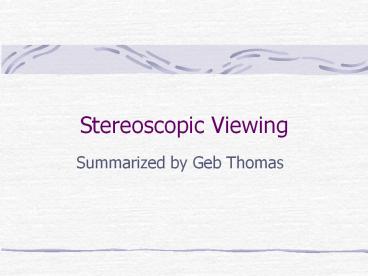Stereoscopic Viewing - PowerPoint PPT Presentation
Title:
Stereoscopic Viewing
Description:
Stereoscopic Viewing Summarized by Geb Thomas Learning Objectives Learn how to calculate retinal disparity Understand the variety of cues that provide depth ... – PowerPoint PPT presentation
Number of Views:97
Avg rating:3.0/5.0
Title: Stereoscopic Viewing
1
Stereoscopic Viewing
- Summarized by Geb Thomas
2
Learning Objectives
- Learn how to calculate retinal disparity
- Understand the variety of cues that provide depth
perception - Understand the main stereo viewing devices and
the differences between them - Understand how to calculate important engineering
parameters of stereoscopic display systems
3
Computation of Retinal Disparity
- Cormack and Fox
- Images of objects nearer or farther than fixation
fall on noncorresponding points on the retinas --
retinal disparity - Typically Assume that all points are on the
horizontal fixation plane
4
Fixation
Angle 1 ATNJAf/Df
Angle 2 ATNJ-Af/Df
Convergence Ang1 Ang2
5
Target
Angle 3 ATNJAt/Dt
Angle 4 ATNJ-At/Dt
ct Ang3 Ang4
r angle cf - angle ct
6
Stereoscopic Displays
- 3D visual display systems for virtual
environments, McKenna and Zeltzer - Display Characteristics
- 5 Display Designs
7
Visual Cues and Display Attributes
- Field of View -- angle subtended by viewing
surface (human eye 120x180) - Spatial Resolution -- pixels (1280x1024 for many
monitors human has fovial region for 1-2 deg,
sensitivity of 2-4 cycles/degree 30 arc-sec) - Refresh and Update rates -- critical fusion
frequency 60Hz, 10-15Hz update rate for motion.
8
Visual Cues and Display Attributes, Cont.
- Brightness -- from 1-1000 mL, response follows
Webers law at 2 contrast. Most displays range
from 2-8 to 20-60mL. - Color -- Trichromatic color reproduction is
somewhat noisy process, limits range of color
reproduction. - Information Rate and Bandwidth -- Human eye info
rate -- 4.3Mbits/sec along nerve pathways,
monitor has 2 Gbits/sec.
9
Visual Cues and Display Attributes, Cont
- Viewing Zone/ Volume Extent
- Number of Views
10
Depth Perception and Depth Cues
- Stereoscopic vrs. Autostereoscopic
- Oculomotor cues -- vergence and accomodation
- Binocular disparity
- Binocular depth resolution
- Motion parallax
- Pictorial Depth Cues -- Overlap, image size,
linear perspective (position), texture gradient,
aerial perspective, shading
11
(No Transcript)
12
Stereoscopic Display
13
Interactive Stereo
14
Lenticular Screen/ Parallax Barrier
15
Slice Stacking
16
Computer-Generated Holography
17
(No Transcript)
18
(No Transcript)
19
Learning Objectives
- Learn how to calculate retinal disparity
- Understand the variety of cues that provide depth
perception - Understand the main stereo viewing devices and
the differences between them - Understand how to calculate important engineering
parameters of stereoscopic display systems
20
(No Transcript)































